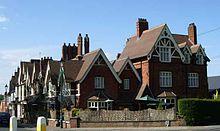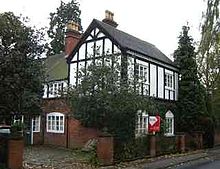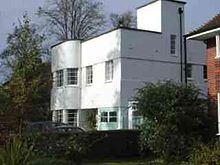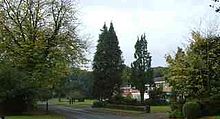- Dorridge
-
Coordinates: 52°22′19″N 1°45′19″W / 52.37196°N 1.755411°W
Dorridge
 Dorridge shown within the West Midlands
Dorridge shown within the West MidlandsOS grid reference SP166749 Metropolitan borough Solihull Metropolitan county West Midlands Region West Midlands Country England Sovereign state United Kingdom Police West Midlands Fire West Midlands Ambulance West Midlands EU Parliament West Midlands List of places: UK • England • West Midlands Dorridge is a village in the West Midlands borough of Solihull, England, with a population of 7800.
Contents
Location
Dorridge is to the East of the M40 and the South of the M42 which, along with a small but important green belt area, separates Dorridge and its neighbours of Knowle and Bentley Heath from the greater urban area of Birmingham, with the town of Solihull encompassing the green-belt area. It falls in the Meriden Gap and historically was part of Warwickshire. Indeed, there are no major towns between Dorridge and Warwick. It is 125 metres (400 ft) above sea-level, located in the Midlands Plateau.
History
Earliest existence
The village of Dorridge did not exist as a community until the mid-19th century, though it is mentioned as far back as the 15th century in the Westminster Muniments which recorded a place called 'Derrech'. It was just the name given to the ridge of land running westwards from Knowle (also then called 'Dorege'). The earliest evidence of settlement though is of Bronze Age man - an axe dated to 1300 BC was found in Norton Green. Cottages dating back to the 16th century exist in Mill Pool Lane. However, the lack of any significant road system until the arrival of the railway showed that there was no community there.
With the rise of Solihull, a road connecting to Hockley Heath became formed. Along this road, the Four Ashes (after which the recently developed estate was named) became a land mark - records show the trees being present in 1662 and marking the Parish boundary. They were also mapped in 1725 even in preference to some local buildings of note. The ashes still exist today near to the driving range, though they have been replaced several times since the earliest records. The Drum and Monkey existed from around 1860, though then it was known as The White Lion Inn.
Impact of the railway
In 1852 the railway was built by the Great Western Railway, originally in Brunel's preferred 7-foot gauge track. Dorridge railway station, which was originally called Knowle, and later Knowle and Dorridge, created the focal point for a new community. The Muntz family granted the land for the railway on condition that a station was built - perhaps less surprising on discovering that the Chairman of the Birmingham & Oxford Railway Company was P. H. Muntz, a relative. There is some folklore about the agreement that suggests that the railway was obliged to stop at Dorridge; however, with the affluent residents of Knowle and Dorridge, it was certainly a commercial practicality. Evidence of the popularity of the railway can be seen in that a "bus" service from the Greswolde Hotel in Knowle was provided in the early days of the railway at the high cost of 6d. In its heyday, the train service ran between Lapworth and Birmingham with four tracks, but by the mid-1960s two tracks had been removed and traffic was declining. The link with London was revived in the 1990s as part of the privatisation of British Rail, initially with single track running south of Banbury. Dual track working was reinstated and today in spite of being a village, Dorridge still has the privilege of being one of the stops on the express service.
Muntz family influence
The development of Dorridge is strongly linked to the Muntz family, who lived in nearby Umberslade Hall. The Muntz family were descendants of Philip Fredrick Muntz, an immigrant of the 18th century, who had left revolutionary France after settling there from Poland. Through industrial wealth, founded on a brass-making process for creating Muntz Metal, a form of brass used in shipbuilding, the family acquired a considerable estate in the area.
Possibly the most famous of the Muntz family was the inventor of Muntz metal, George Frederic Muntz, who was also an early Member of Parliament for Birmingham. He was a supporter of political reform and a founding member of the Birmingham Political Union along with Thomas Attwood. In his actions that led to the Reform Act 1832 Muntz was indicted for sedition as he tried to undermine the Duke of Wellington with a run on gold — To stop the Duke, run for Gold. He also was involved in a riot at St Martins in Birmingham in protest against the Church Rates which were levied at around 6d to 9d in the pound. He was sent to trial in 1838 but was acquitted on all but one of 13 charges. Whilst claiming to be a Republican, his true character appeared to be that of an egotistical aristocrat. E. Edwards wrote in 1877 in the Birmingham Daily Mail of a conversation about a speech he made: "They won't be able to print Muntz's speech verbatim." "Why not?" said I. "Why my dear fellow, no printing office in the world would have capital I's enough."[1]
William Muntz built, owned and resided in the Forest Hotel, and it is suggested that in part this was created as a stopover for the family and guests to allow an early morning train departure to London. The Forest Hotel, the building is still owned by the Muntz Family.. To support the growing community, the family built the shops and houses of Station Approach, including a doctor's surgery. The family also guided much of the development of Dorridge as a desirable residential area, though the farming family of the Trueloves recognised the need for affordable housing for the 'less wealthy artisans' and built the terraced housing that remains in Poplar Road.
Middlefield Hospital
Dr. Fletcher of Dorridge, together with Jonathan Henry Kimball of Knowle also provided for an 'Asylum for 20 Idiot Girls' in the mid-19th century, in 'Dorridge Grove' which was on the site of the former 'Railway Tavern'; the building still exists as a distinctive house on Knowle Wood Road. It is worth noting that the term 'idiot' was a specific term for those considered ineducable, and was considered different from insanity. The records of the early years show that it was a successful enterprise, surprising those who visited that they achieved so much improvement in the behaviour of the patients.
The demand for this facility was such that a purpose built Idiot Asylum was then built in 1872 for the princely sum of £10,000 near Grove Road. The construction of this was something of a national event: representatives of 100 Masonic Lodges marched from Knowle Station to take part in the laying of the foundation stone, which was set in place using the same mallet used by King Charles the Second to lay the foundation stone of Saint Paul's Cathedral in London. The asylum was funded mainly by the local Counties of the Midlands, but George Fredrick Muntz sponsored competition with a prize of £100 for the best design. It provided for housing idiot children from all over the Midlands. It is perhaps telling that in 1867 it was renamed to be the 'Midland Counties Middleclass Idiots Asylum' and although subsidised, families typically had to pay an annual fee to have their children placed there. This was extended in 1893 and evolved into the Middlefield Hospital which existed on the same site until the 1980s, having been adopted by the National Health Service in 1948.
Development of housing
Dorridge was not considered a district in its own right until 1940. At the turn of the 19th century, much of what is now Knowle Wood Road, (was then Packwood Road) was farmland with just a few dwellings, similarly Avenue Road (which was then Warwick Road) had a handful of dwellings. By the 1930s the main Dorridge Triangle was properly established. Aside from the substantial family homes, there are a significant number of mansions, some of which, such as Parkfield near the park, have now been converted into flats.
During the 1930s, development slowed, and it was not until the 1950s that expansion gathered pace again. One of the earliest post-War developments was Kingscote Road, one of the few developments of semi-detached housing in the area, followed by the near-by Rodborough Road development in 1960.
There was a substantial development in the 1960s around the area christened by estate agents as the "Golden Triangle" — alluding to the expensive and desirable housing of the area bounded by Dorridge Road, Avenue Road and Knowle Wood Road. Even then the local press noted the high cost of housing, noting many houses cost a 5 figure sum, and that 2 and 3 car households were well above the national average. The population expanded rapidly: there were around 600 dwellings in 1955, which expanded to 1800 by the mid-1970s to somewhere above 2500 homes by the year 2000.
Whilst there is a history of locals taking a dim view of developers, a local developer, Mr Ford, gifted the land which is now Dorridge Park to the community in 1965.
In the late 1990s another substantial development was built on former farmland in the area known as Four Ashes, behind the Porsche Centre Solihull, and the development of the Middlefield Hospital site occurred at a similar time.
The architecture is a reflection of this development — there are some fine buildings from the Victorian era all around the area. Over the years, each period has then added buildings of its style — Avenue Road, for example, has classic Art Deco houses with rounded metal-framed windows. Building sizes were restricted in the post-war era. Buildings in the 1960s, though of limited architectural merit, were built with large gardens; many owners have since imposed character on these houses. More modern developments have seen the move to build apartment-style blocks, though there have also been substantial houses built, often on the site of much smaller houses and at the expense of the large gardens that still characterise the area.
Schools
It is surprising that although the Infant and Junior schools today have over 750 pupils, until as recently as 1955 there were no schools in Dorridge, with pupils travelling to Bentley Heath, Hockley Heath, Knowle or Packwood to get an education. In 1955 Dorridge Junior School was built and by 1963 an Infant School was built. These were joined by the Catholic School of St. George and Teresa. The secondary education is mainly provided by Arden School in nearby Knowle, which now also has a sixth form centre. The sixth form buildings were completed in 2007 with additions being made every year. A considerable number of children go to private schools in Solihull, Warwick or Birmingham or to grammar schools in Birmingham or Stratford.
Commercial development
When coming to Dorridge today, a visitor would be surprised to know that there was significant activity in the area over the last hundred years.
Between the Station and the level crossing at Bentley Heath a significant goods yard existed. During the 1960s the Austin Motor Company used it to deliver up to 600 cars a day for export, via the railway.
A brickworks, the Knowle Brick Company, existed in Mill Lane which ceased production as recently as 1969. Mill Lane also had a large milk-distribution depot until the mid-1990s. On a smaller scale, Dorridge Road had a marble works, handling imported stone from Italy and elsewhere. Further down in Blue Lake Road, there was Blue Lake stores, this was also a cycle repair shop, there was also a print shop, the building which is the distinctive shed of Steve's Mowing. Nearer the centre of Dorridge, in the building now occupied by the architects, there was a Cabinet Maker, Wallace and Champness.
A gasworks was developed on land that, as of 2005, was known as Eveson's, a fuel merchants, but this land has now been developed into flats. Many of the buildings around the area that is now a Conservation Area — Station Approach — date back to the turn of the century or before, though aside from the Forest Court shopping centre and the HSBC Bank, now closed, the centre is essentially unchanged from the mid-1950s.
There were three garages in Dorridge, Four Ashes Garage on Four Ashes Road (just down from the Drum & Monkey), Station Garage on Grange Road & Roy Tetthers / Widney Service station on Widney Road.
Four Ashes Garage & Station Garage were both there before WW11, Four Ashes was bought by Jack Moss (an apprentice at Wolseley Motors (1927) Ltd) in 1954, it was a small wooden garage then which Jack Moss had rebuilt into a modern garage (at that time) in the late 1950's, when he moved the Company to Stratford upon Avon at Christmas 1976 it became a Nissan dealer & then a Toyota dealer (both Mike Grimes) now it is a Porsche dealer.
Station Garage, Grange Road also housed a thriving taxi business after the war, it became Colmore depot sometime in the 1960's & is now just a petrol station.
Roy Tetther was based at Widney Service Station servicing cars until the early 80s, now its just a petrol station.
F.W Mead Coachbuilders (Richard Mead's) built car bodies for Jowett's, Bristol's, the Marauder & others in a property off Poplar Road, (between the 1st row of houses on Poplar Road & Arden Buildings now the Drawing Room) it was recently Archers car bodyshop, this now has flats built on the site.
To support the growing township, the 'controversial' Arden Buildings were built - considered to be quite out of keeping with the fine architecture of Dorridge, and in 1965, the Forest Court Shopping Centre was developed at a cost of £20,000, originally an open air shopping centre, it was then covered over in the late Eighties / early Nineties, this has had the unwelcome effect of hastening its decline.
The increased pressure for car parking led to the bowling green behind the Forest Hotel being developed into a car park. The bowling club moved to Hockley Heath - the bowling club next to the Railway Inn was in turn displaced from behind the Red Lion pub in Knowle, again to develop car parking.
In 2008, Sainsbury's revealed that they had purchased a long lease to redevelop the Forest Court shopping centre and also owned part of the Station Approach Conservation Area which they intend to refurbish.[2][3] An independent local group, Dorridge Residents Opposed to Village Superstore was formed in 2010 as a focus of opposition to any re-development of Forest Court which, it is argued, would be inappropriate in scale for the existing village centre.
Dorridge today
The station again fulfils an important role providing easy travel to London and Birmingham, for Dorridge and for numerous local villages such as Knowle, which do not have a railway station, with Chiltern Railways having created an inter-city route out of the run-down remnants of what had become primarily a goods line. A London Midland route now terminates in Dorridge or Leamington Spa, from Birmingham.
Dorridge is neither urban nor a village. However, it sits right next to the Warwickshire countryside, with green fields being a short walk from the town centre.
It has a small shopping centre, a village hall, at least three churches and also an excellent primary school (Dorridge Junior School). It has a substantial park bordering the countryside. There are a few small restaurants, and three pubs: The Railway Inn (nowhere near the railway), the Forest Hotel (right next to the railway) and the Drum and Monkey near the Four Ashes estate.
Accommodation is available at the Forest Hotel and at Hogarths. Nearby is a golf driving range and a riding Club. It has two cricket clubs. It also has a tennis club and Ye Olde Knowle Bowling Club[sic]. Solihull is just five minutes' drive away with its modern shopping centre, cinema and variety of sports facilities.
The property prices around Dorridge are amongst the highest in the West Midlands region, in part driven by the perception of desirability of the local state schools, the easy access to the main motorway system and the airport, as well as the train links mentioned earlier, but in part it is also a reflection of the well-spaced gardens and large houses. In 2005, several houses changed hands for over £1,000,000 according to the land registry.
There are a number of notable residents who live here or very nearby, Jasper Carrott, The Office actress Lucy Davis, Sir Adrian Cadbury, Karren Brady former Managing Director of Birmingham City F.C, Steve Bruce, former manager of Birmingham City F.C, former England International Lee Hendrie alongside many other professional footballers and Musicians Bev Bevan, Harry Sutcliffe and Russell Leetch.
Dorridge is part of the Meriden constituency, MP Caroline Spelman who also lives nearby, though is due to be split from Meriden under the current boundary review, forming a separate constituency of Dorridge and Kenilworth with the nearby castle town of Kenilworth. Dorridge is regarded as a Conservative stronghold.
Community groups
Aside from the strong church communities, the town benefits from a Round Table, a Residents' Association, drama groups and youth organisations including the strong Dorridge Scout Group. Some of the organisations are shared with Knowle, such as Knowle Sea Scout Group for young people aged 6 to 18.
Residents' Association
The Residents' Association was formed in 1961. It was formed in response to concerns over unwelcome developments and also helped develop facilities for local residents. In 1974, Dorridge Day was first held as a fundraising event for the Village Hall which was opened in 1976. The Dorridge & District Residents Association first ran the event, though in recent years, Knowle and Dorridge Round Table have run this popular annual fair.
Anglican Church
With the growing population, the need for a Church was recognised and St. Phillip's Church was built in 1878. It soon had to be expanded.
Catholic Church
Originally, the Catholic population had no formal meeting place but meet in Cross Close, a house in Arden Drive. In 1917 St. George & St. Teresa's church was built on Station Road. This burnt down in 1935 and was replaced with the substantial building on the same site, which still exists today. In 2006, a parish centre was added to the church.
Methodist Church
The Methodists put down their roots in 1958 with the arrival of their church in Mill Lane. The church has proved very popular and now has a substantial congregation.
Baptist Church
In 1877, George Fredrick Muntz founded the Baptist Church at Nuthurst, adjoining Hockley Heath. In later years, due to ill-health, he had a microphone system installed and linked to Umberslade Hall so he could hear the services.
Christadelphian Church
Knowle and Dorridge Christadelphians meet in Dorridge Village Hall on Sundays.[4]
Round Table
Knowle and Dorridge Round Table 812 was founded in 1964. For many years its regular meeting place was in Knowle, but the membership has always been drawn from the two communities. Whilst primarily a friendship organisation, it supports local charities, with the two main events it runs being Dorridge Day and the Christmas sleigh, visiting nearly every street in the area every December.
Dorridge Scout Group
Dorridge Scout Group was formed from the old 1st and 2nd Dorridge Scouts. It is a strong group providing adventure to over 300 young people each week. It also has an Explorer Scout Unit for older children called Darwin.
Places of interest
Nearby there are the historic buildings of Packwood House and Baddesley Clinton now in the care of the National Trust, and the Grand Union Canal is in walking distance with both the Heron's Nest and Black Boy pubs being accessible. The Stratford-upon-Avon Canal also links in and is notable for a large flight of locks that descend into nearby Lapworth from Birmingham.
A short distance away, Knowle has a 600 year-old church, and a number of buildings dating back to the 16th century, including a recreation of a knot garden.
The ancient town of Warwick is a short drive away, notable for its castle.
To the West, just across the M42, there is a nature reserve at Blythe Valley Business Park. The park is next to the River Blythe which is a Site of Special Scientific Interest. Footpaths run from Dorridge both to the Park and to Solihull's Brueton Park, the latter at times running alongside the River Blythe.
Also to the West located along Four Ashes Road is a Golf Driving Range established in 1983
References
- ^ Edwards, E (2007). Personal Recollections of Birmingham and Birmingham Men. Teddington, Middx.: Echo Library. pp. 136. ISBN 9781406862911. http://books.google.co.uk/books?id=cE9AyKaLIwwC. Retrieved 11 July 2011.
- ^ "Sainsbury's Dorridge Consultation Site". http://www.sainsburysdorridge.co.uk/. Retrieved 2009-01-15.
- ^ "Residents Association Site". http://www.dorridge.org.uk/. Retrieved 2009-01-15.
- ^ "Knowle & Dorridge Christadelphians". http://www.knowleanddorridgechristadelphians.org/. Retrieved 2007-05-29.
Further reading
- Around Knowle & Dorridge. Charles Lines, 1996. Alan Sutton Publishing Limited. ISBN 0-7509-0817-3
- The Rise of the Commuter Village of Dorridge. Gem Bradley. Unpublished Thesis, 1972.
- Personal Recollections of Birmingham. E Edwards, 1877.
- Bentley Heath and Widney Manor. Edna G Handley, 1992. ISBN 0-9519897-0-7
External links
- Dorridge and District Residents Association
- Solihull and Leamington Rail Users Association
- National Statistics for Dorridge
- Old Maps From the search screen, type Dorridge and you will be presented with a map from around 1899.
- Solihull Riding Club
- Knowle & Dorridge Cricket Club
- Dorridge Cricket Club
- Knowle and Dorridge Round Table
- Knowle Sea Scout Group
- Dorridge Infant School
- Dorridge Junior School
- Ye Olde Knowle Bowling Club (next to the Railway Inn)
- Solihull Cycling Club
- Evesons Fuels
- Dorridge Village Hall Association
- Dorridge Residents Opposed to Village Superstore
Categories:- Villages in the West Midlands (county)
- Solihull
Wikimedia Foundation. 2010.





